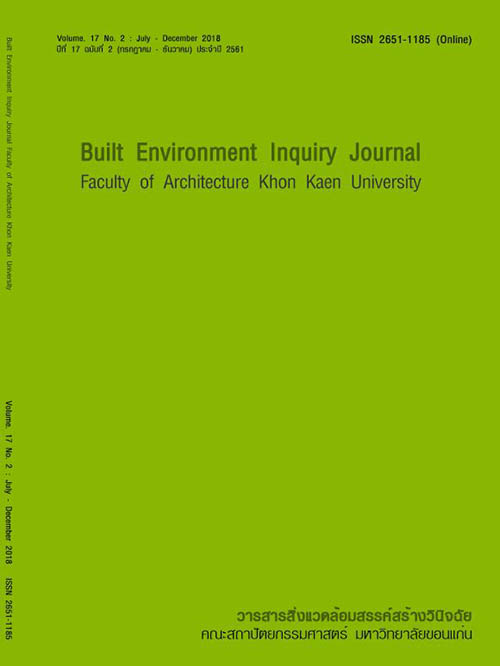การวิเคราะห์ศักยภาพเชิงพื้นที่เพื่อการพัฒนา TOD เมืองขอนแก่น
คำสำคัญ:
การพัฒนาพื้นที่รอบสถานีระบบขนส่งสาธารณะ ประเภทของการพัฒนาพื้นที่รอบสถานี ศักยภาพเชิงพื้นที่ เมืองขอนแก่นบทคัดย่อ
บทความนี้เป็นส่วนหนึ่งของการศึกษาออกแบบรายละเอียดระบบขนส่งสาธารณะในเขตจังหวัดขอนแก่นและผลกระทบสิ่งแวดล้อม โดยการสนับสนุนของสำนักงานนโยบายและแผนการขนส่งจราจร กระทรวงคมนาคม มีวัตถุประสงค์หลักเพื่อวิเคราะห์ศักยภาพเชิงพื้นที่ของพื้นที่รอบสถานีรถไฟฟ้ารางเบาและสถานีรถไฟขอนแก่นรวม 17 พื้นที่ การวิเคราะห์เชิงพื้นที่ประยุกต์ใช้หลักการจำแนกประเภทของ Transit-Oriented Development (TOD) จากกรณีศึกษาเมืองในประเทศสหรัฐอเมริกา การวิเคราะห์ศักยภาพเน้นพื้นที่หลักในระยะ 500 เมตรโดยรอบสถานี แต่ละพื้นที่จะถูกวิเคราะห์ตามพื้นฐานปัจจัยหลัก 2 องค์ประกอบ รวม 11 ตัวชี้วัด คือความพร้อมทางกายภาพของพื้นที่ 6 ตัวชี้วัด และศักยภาพการดึงดูดการลงทุนในพื้นที่ 5 ตัวชี้วัด ผลของการวิเคราะห์ทำให้สามารถจำแนกประเภทของ TOD ตามศักยภาพเชิงพื้นที่ ณ ปัจจุบันได้ 3 กลุ่ม โดยแต่ละกลุ่มมีลักษณะตามกรอบการพัฒนา TOD ในระดับที่ต่างกัน ซึ่งนำไปสู่การนำเสนอยุทธศาสตร์การพัฒนาพื้นที่รอบสถานีระบบขนส่งสาธารณะเมืองขอนแก่นเพื่อยกระดับศักยภาพเชิงพื้นที่ให้สามารถพัฒนาเป็น TOD และเป็นกลไกในการขับเคลื่อนการพัฒนาเมืองขอนแก่นในอนาคตต่อไป
References
สำนักงานนโยบายและแผนการขนส่งจราจร. กระทรวงคมนาคม. (2559). แผนการพัฒนาพื้นที่โดยรอบพื้นที่สถานีหรือจุดจอด (TOD) และพื้นที่ต่อเนื่องในเมืองขอนแก่น (รายงานฉบับสมบูรณ์). กรุงเทพฯ: สำนักงานนโยบายและแผนการขนส่งจราจร.
Belzer, D., Autler, G., Espinosa, J., Feigon, S., and Ohland, G. (2004). The Transit-oriented development
drama and its actors. In H. Dittmar & G. Ohland (Eds.), The New transit town: Best practices in transit-oriented development. Washington. DC: Island Press.
Calthorpe, P. (1993). The Next American metropolis: Ecology, community, and the American dream. New York: Princeton Architectural Press.
Dittmar, H. & Poticha, S. (2004). Defining transit-oriented development: The New regional building block. In Dittmar H., & Ohland, G. (Eds.), Transit town: Best practices in transit-oriented development. Washington: Island Press.
Suzuki, H., Cervero, R., & Iuchi, K. (2013). Transforming cities with transit: Transit and land-Use integration for sustainable urban development. Washington DC: The World Bank.
ฐานข้อมูลอิเล็กทรอนิกส์
Bertolini, L. (1999). Spatial development patterns and public transport: the application of an
analytical model in the Netherlands. Planning Practice and Research, 14(2), 199-210. doi: 10.1080/02697459915724
Calthorpe Associate. (1990). Transit-oriented development design guidelines. Retrieved from: https://www.per.saccounty.net/LandUseRegulationDocuments/Documents/General-Plan/TOD-Design-Guidelines.pdf
Calthorpe Associate. (1992). Transit-oriented development design guidelines: City of San Diego. Retrieved from https://www.sandiego.gov/planning/documents/pdf/trans/todguide.pdf
Center for Transit-Oriented Development (CTOD). (2007). Station area planning Manual. Retrieved from: https://www.ctod.org/portal/sites/default/files/station_area_planning_manual_nov07.pdf
Center for Transit-Oriented Development (CTOD). (2010). Performance-based transit-oriented development typology guidebook. Retrieved from https://www.cnt.org/sites/default/files/publications/CNT_TODTypologyGuidebook.pdf
Center for Transit-Oriented Development (CTOD. (2011a). “Transit-oriented developments strategic plan / Metro TOD program.” Report for Metro TOD Program in Portland, OR. Retrieved from https://ctod.org/pdfs/2011PortlandTODweb.pdf
Center for Transit-Oriented Development (CTOD). (2011b). Connecting the west corridor communities: An implementation strategy for TOD along the Denver Region’s west corridor. Retrieved from https://ctod.org/webinars/20110719/WestCorridorWebinar20110719.pdf
Cervero, R. (2004). Transit-oriented development in the United States: Experiences,
challenges, and prospects (TCRP Report 102). Washington, D.C.: Transportation Research Board. Retrieved from https://nap.edu/23360
Cervero, R. (2013). Linking urban transport and land use in developing countries. The Journal
of Transport and Land Use, 6(1), 7-24. Retrieved from https://dx.doi.org/10.5198/jtlu.v1.425.
Cervero, R., & Kockelman, K. (1987). Travel demand and the 3Ds: Density, diversity, and design. Transport Research Part D: Transport and Environment, 2(3), 199-219. Retrieved from
https://doi.org/10.1016/S1361-9209(97)00009-6
Chorus, P., & Bertolini, L. (2011). An application of the node place model to explore the
spatial development dynamics of station areas in Tokyo. The Journal of Transport and Land Use, 4(1), 45-58. doi: 10.5198/jtlu.v4i1.145
Ferbrache, F. & Knowles, R. (2017). City booterism and place-making with light rail transit: A critical review of light rail impacts on city image and quality. Geoforum, 80, 103-113. Retrieved from https://dx.doi.org/10.1016/j.geoforum.2017.01.013
Florida Department of Transportation (FDOT). (2011). A framework for transit oriented development in Florida. Retrieved from https://www.fltod.com/renaissance/docs/Products/FrameworkTOD_0715.pdf
Hale, C., & Charles, P. (2007). A step-by-step approach to transit oriented development project delivery. Paper presented at the 11th World Conference on Transport Research, University of California, Berkeley. Retrieved from https://www.researchgate.net/publication/37621354_A_Step-by-Step_Approach_to_Transit_Oriented_Development_Project_Delivery
Higgins, C., & Kanaroglou, P. (2016). A latent class method for classifying and evaluating the performance of station area transit-oriented development in the Toronto region. Journal of Transport Geography, 52, 61-72. Retrieved from https://doi.org/10.1016/j.jtrangeo.2016.02.012
Kamruzzaman, Md., Baker, D., Washington, S., & Turrell, G. (2014). Advance transit oriented development typology: Case study in Brisbane, Australia. Journal of Transport Geography, 34, 54-70. Retrieved from https://doi.org/10.1016/j.jtrangeo.2013.11.002
Kim, H., Sultana, S., & Weber,J. (2017). A geographical assessment of the economic
development impact of Korean high-speed rail stations. Transport Policy. Advance online publication. Retrieved from https://doi.org/10.1016/j.tranpol.2018.02.008
Lyu, G., Bertolini, L., & Pfeffer, K. (2016). Developing a TOD typology for Beijing metro station areas. Journal of Transport Geography (55), 40-50. Retrieved from https://dx.doi.org/10.1016/j.jtrangeo.2016.07. 002
Papa, E., & Bertolini, L. (2015). Accessibility and transit-oriented development in European
metropolitan areas. Journal of Transport Geography, 47, 70-83. Retrieved from https://dx.doi.org/10.1016/j.jtrangeo.2015.07.003.
Ratner, K., & Goetz, A. (2013). The reshaping of land use and urban form in Denver through transit-oriented development. Cities, 30, 31-46. Retrieved from https://dx.doi.org/10.1016/j.cities.2012.08.007
Downloads
เผยแพร่แล้ว
How to Cite
ฉบับ
บท
License
ทัศนะและข้อคิดเห็นของบทความที่ปรากฏในวารสารฉบับนี้เป็นของผู้เขียนแต่ละท่าน ไม่ถือว่าเป็นทัศนะและความรับผิดชอบของกองบรรณาธิการ




